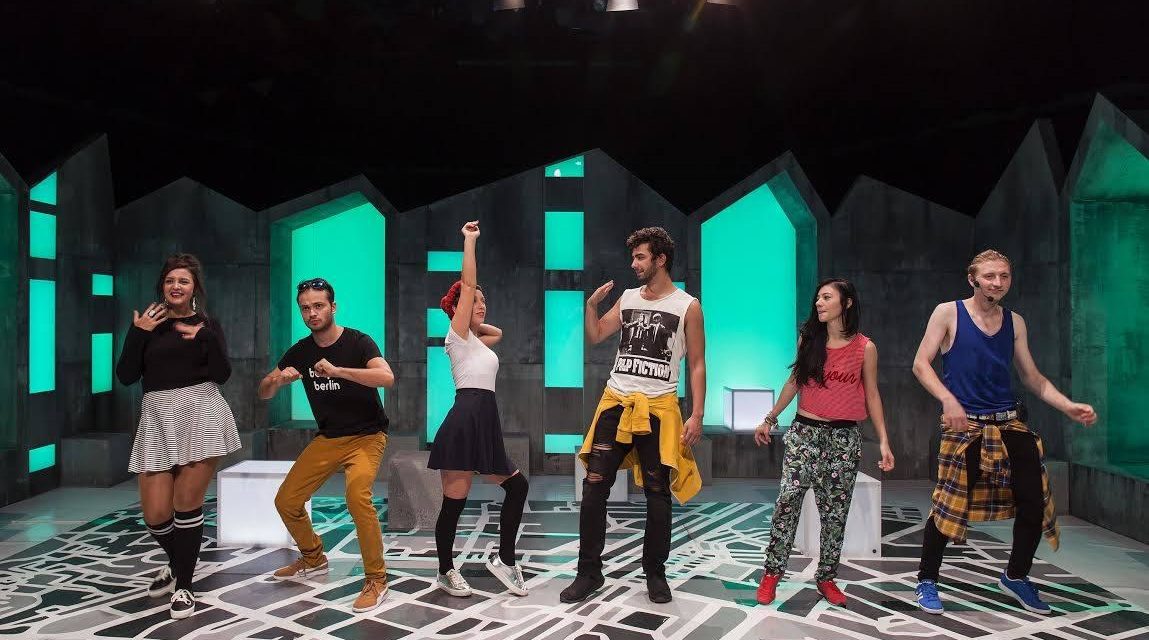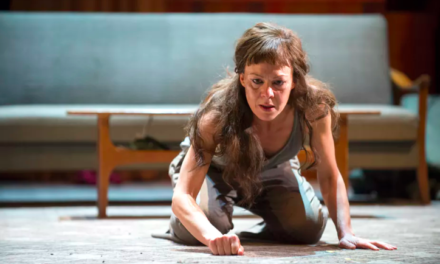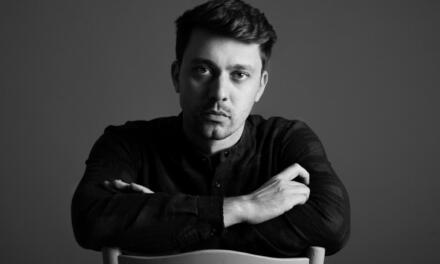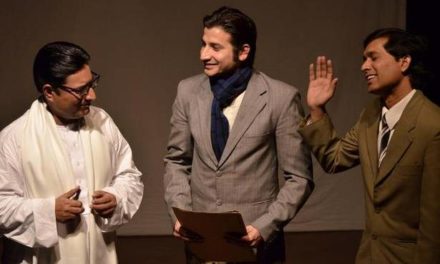The very moment I step into the building, great expectations surround me. If a measuring device existed for such feelings, the degrees of suspense would surely become visible. I enter each room highly curious and slightly heavyhearted, but, after scanning each room and discovering what is inside, I feel the simple joy of discovery and no longer want to leave. I find there the deserted scene of a feast, with a large table, plates, glasses, wine stains, a tablecloth angrily pulled off; in a different room, a character seemingly descending from another century is buried amongst files behind a table lit by a reading lamp: he lifts his eyes to me, watches me as if he knew more than he could say, his smile elongates between his two bushy sideburns, and then his nose returns to the yellowed pages. I cross a large space, covered by snow or something similar, blizzard-like sounds come from nowhere; I feel more and more the coldness, and I finally see, at a distance, a tiny little house, lit in the middle of the snow, but I am admonished to hurry, so I pass by quickly, trying not to lose the miraculous feeling its appearance gives me. Somewhere else, before my eyes, a bookcase’s shelves seem to have turned into insectariums with tiny beings pinned in, with their rooms full of little furniture, made of wood, domestic objects, and small stuff; you get the feeling that you are watching through a looking-glass, and that they simply refuse to grow bigger under your eyes; it is like you are compelled to see things in perspective, forced not to miss “the bigger picture.” The same size, the couple dancing an endless waltz in a room where you feel as well the impulse to dance, so vibrant the music wave is, it surrounds you like an alien presence; there, in halls, in the passages from one room to another, one can spot bizarrely costumed creatures, napping on chairs leaned against walls, and their presence is a reminder that one is not dreaming or, at least, that this is the dream of someone else who has generously invited a selected audience to experiment it together.
This is theatre as personal experience, as a sensorial impulse, which generates different expectations for the participating spectator and tells customized stories, different for each and any of us, that according to our own staging we are encouraged to create. I myself have lived the aforementioned scenes during the performances Before I Sleep and Don’t Look Back, created by the ThinkDreamSpeak British company, managed by Tristan Sharps, and I am describing them now and here the way I remember them, recorded by my mind as a professional spectator, too loaded, perhaps, by the hundreds, possibly thousands, of performances seen in more than twenty years now.
But, amongst all, these two performances stayed with me, their memory empowered by the sensorial map they created. Of course, there is another level of my experience, the intellectual one, which coagulates the significant connections in the story of Orpheus, who descended to the Underworld to recover Eurydice, but gave in to the temptation to look back to see his lover, and therefore lost her forever (Don’t Look Back). The feeling that this is the end of it, that this may have been your last trip, is acutely perceived in the room on the ceiling of which the video of a funeral is projected, seen from the perspective of the individual(s) already lying in the hole dug for the grave. The weight of the earth hitting the camera is borne at different intensities by each and every spectator watching the projection on the ceiling, head back, in a fragilized position for the watcher. It is also from an intellectual point of view that we make the connections which reconstruct the sad story of everything left behind by the wave of the “new,” the imaginary cherry orchard which can mean different things for each of us (Before I Sleep was inspired by Chekhov’s The Cherry Orchard). But what really makes me remember these performances after years are the sensations I experienced during the representations.
A long introduction to say that Romanian theatre has begun to be touched more and more by the temptation of “immersive” theatre performances, where the spectator becomes a direct participant and is totally immersed, challenged to go his or her own way, in default of any obstacles or “walls” of theatrical protection, in default of a text to deliver meanings easily, compressed in words. The signs are still shy, and sometimes they come where you expect less from, especially that there is no systemic encouragement of creative directions in the theatre areas for the moment, either state or private. We shall not wait for too long until such “postdramatic emancipation” will gain more and more ground, defining what I believe to be the following steps of the evolution of the Romanian performative stage.
For more than a decade, the major signs of creativity on this stage related to the approach to social topics strongly focused on the ethical involvement of the young creators, [1] but approaching the end of the second decade of this wave we can already identify a saturation of the local stage related to this direction. A new generation of creators–actors become directors or choreographers, directors with an accentuated sense of visual composition, playwright-directors, playwright actors or simply artists from different fields working collectively and leaving aside preset hierarchies to find their own collaborating formulas–promises to leave its mark by a different kind of performance.
More about some of them follow.
I. “It is preset like this in the system”
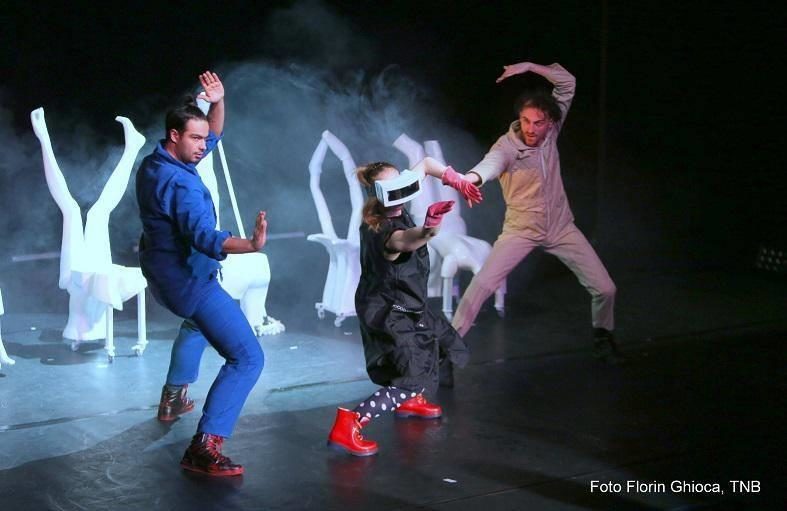
April 2017. The Hungarian State Theatre from Cluj Napoca is about to fulfill its preparations for the first performance in the Shortcut series, opened to new names in Romanian theatre. The theatrical team, fully professional, has finished installing the set and is awaiting the public, which is about to fill the hall at both representations and to stay for discussions afterward, pleased to ask questions. In my capacity as curator of what we wanted to be a series dedicated to making young creators more visible more quickly, I am nervous because we are to open with an unusual performance, not at all “perfect,” but bold enough to open doors that few artists dare nowadays to open, in Romania. Including that of collaborative work, an aspect I look forward to discussing and explaining to the public as well. I glance at my ticket and see below the title of the performance, (D)efectul Placebo (Placebo (D)effect), “director Ștefan Lupu.” Ștefan was the team coordinator; he is an actor turned dancer and choreographer, but he is not properly labeled “director” in this case. But who could be, of the five protagonists? Each participated in writing the texts; they all chipped in with stage movement, costumes, dramatic situations, and related ideas. As he is to explain later, in the discussion after the second performance, Ștefan edited the texts, rehearsed the choreography with his colleagues, decided not to appear onstage in this performance (he dances and plays in too many others), but travels with it when they are invited somewhere. Who should have been labeled “director” on my ticket, when there is no one fully suitable, actually, to be identified as such, or maybe everyone is? And, in the end, why the need to tick such a box on the ticket issued? “We have to fill that space in with just one name; that’s how it is released by the computer” is the answer I get for my question. “It is preset like this in the system.”
And everything becomes clearer: it is not enough to swim against the current, to remain loyal to your own intentions as a creator, to be so strong in what you propose as to convince, sometimes sabotaged by the absence of an appropriate degree from a university; it is not enough to conquer the people to believe in you and to promote/invite you /write about what you are doing, and it’s not even enough to fill the halls with spectators who really buy tickets: you need to continuously press the accelerator up to the moment there occurs a change “in the system.” Up to the moment that the predefined box in the computer program includes something different from the old hierarchies of the stage. Because only at that point will everybody see it clear that one single word–director–can no longer include today all the nuances of teamwork.
II. A Green Cat
June 2015. Rehearsals are ongoing at Luceafărul Theatre from Iași for a new performance. This is all I know before getting onstage and receiving a pair of oversized headphones and hear not only music but also the voices of the actors I see before me. It is only a general rehearsal, but one immediately notices the unusual dramatic rhythm, marked by changes in the discourse from one character to another, monologues which seem to be separate, closed in the solitude of the characters uttering them, but whose meanings merge towards the end, consisting of a larger picture of a dramatic story with and about teenagers. The actors dance while saying their monologues; they speak in turn, but they are all onstage the whole time, and the disco rhythm induces its cadence to their words. Director Bobi Pricop chose the silent disco format to diminish the possible pathetic echoes generated by the honesty and directness of the words said.
The textual fragmentation skillfully used by playwright Elise Wilk produces in her texts not only a rich poeticism, abounding in emotions self-censored by a kind of inner delicacy of her fragile and complex characters, but also offering more freedom to those who will stage them, who fill the empty spaces with their own ideas, oriented towards connecting to new generations.
A Romanian playwright of German origin and a gifted translator of German plays, Elise Wilk writes for “the following generation,” the present-day teenagers alienated in their relationship to their parents’ generation, with which they have too little to share, connected to each other not by what they feel or say but by the devices they use, drowned in the wave of technology which consumes them and casts them away afterwards on the shore of each day, tired and lonely. Therefore, the directors’ staging ideas naturally and creatively go towards the insertion in the performance of such new technologies, so that young spectators recognize the “strange animal” arisen: a live performance, played in front of them onstage. The best creations of the type were, up to now, iHamlet, directed by Catinca Drăgănescu, a rewriting of the main themes from the Shakespearean play for youngsters (a production of the Asociația Punct & Teatrul Excelsior), and Pisica Verde (The Green Cat), directed by Bobi Pricop (produced by the Luceafărul Theatre from Iași), the performance mentioned above.
If the former incorporates new technologies particularly in its visual dimension (by projections) and in the intimate texture of the show (the scenery recollecting the constructivist silhouettes is half-covered by a beaded curtain, which is also a good support for the projections), the latter turns the performance space into a dance stage and mixes actors in with spectators, bringing them close, even as “accomplices,” through the agency of the silent disco headphones.
“The spectators will dance as well on the rhythm sound from their earphones”, I am told at the end of the rehearsal in Iași. They have probably noticed how rhythm invaded me, and how my body began slightly to move to it. An additional layer of meaning was added by placing the actors close to the spectators, in a common space simulating a disco club, with a sound system which creates an intimacy amongst those sharing it, separating them from the rest of the world. A common reference system awarding freedom of movement to all its participants, and marking the spectator’s emancipation from the passivity usually induced in a conventional theatre. A dancing spectator, moving along with the actors, entering the trance of an addictive rhythm, is a participating spectator, much more involved in the performance, which he or she shall relate to not only intellectually but also sensorially.
In a recent message, a famous French translation company asked me to recommend new playwrights from Romania using a phrase that got stuck in my mind, being significant for defining the development stages of our national dramaturgy, reconfirmed from the outside, coming from another culture: I was asked, therefore, to recommend “new Romanian dramatic voices, post-Cărbunariu and post-Michailov”. [2] My recommendation: Elise Wilk.
In other words–kind of a green cat.
III. Creative Chaos
June 2017. At Gong Theatre from Sibiu, youth groups are crowded before the stair leading to the studio, waiting to enter after the press and official guests take their seats. A long-expected performance is to be played, produced by Creation and Experiment Reactor from Cluj Napoca (a small independent theatre born four years ago). To think that theatre surveys in Romania have always ranked the “experiment” last in public preferences. Seems like no one has ever asked the young people crowding here.
In no time the hall fills, and the performance begins with its sound at the maximum, like in a dance club, followed by a lot of stage smoke, crazy disco lights and some calmer moments, marked by songs excellently interpreted by the three young actresses and an attempt to directly empathize with audience members, who receive special à la Cluj Napoca cookies (I don’t remember what they were called). The All Over Your Face performance created by Botond Nagy with Paula Rotar, Denisa Blag, and Ioana-Maria Repciuc was far from perfect (whatever that means for theatre ”judges.”) Dramaturgically speaking, it was chaotic and unequal, possibly perceived aggressively by sensitive spectators; but, on a sensorial level, it conveyed huge energy, plus the implicit and explicit pleas to break open old theatrical formulas. And what healthier and natural gesture in one’s twenties is there than breaking open pre-existing formulas? In a recent interview on Scena.ro [3], Botond Nagy recollected, “We, the young, are the fine and violent sounds leading your way home at sunrise.” I can only hope that his next shows will lead us, after the necessary explosion of the challenged formulas, towards a personal universe, worth wandering.
In the immediately following pages of Scena.ro [4], another young director, Iris Spiridon, proves in her statements a radicalism which decommissions the spectators themselves; for her, theatre becomes ”a personal business,” self-knowledge and a method to explore her own universe, next to working partners resonating with the same universe and feeling like home in there. So much like home that the limits between the professional and the personal blur, diminishing the capacity of the director to correctly evaluate the performances of the actors she works with. Fetish actors, ultra-performative, can be found in all the performances of this creator up to now. This is another way of blurring the limits between fiction and reality, feeding the voyeurism of a public who constantly need new forms of seduction.
IV. Presence/Absence of Technology in a Performance
August 2017. I am reading the projects–more than 30!–sent to the Hungarian State Theatre from Cluj Napoca after the call it launched within Shortcut, a project to launch new voices of the Romanian theatre. I notice happily that all the young directors under 35 years of age, with interesting things to say recently, plus some completely new names, fresh graduates, have proposed projects. More than that, I discover a constant in their proposals–either in the descriptions of the performance-related concept, or in their scenery sketches attached–something less visible in their previous shows, but quite clear here, one step before getting on stage: the presence of technology. Ranging from mentioning video as an illustrative element or for ambience purposes, to special remarks related to the well-integrated multimedia features of the proposed project, with live cameras onstage and filming the actors in real time, to articulating the discourse of some characters who are only present in video format, completing the magical dimension of the performance, technology gets in many of these proposals an essential role, related in most cases to the concept of performance. It makes me think of the “mediaturgy” [5] that Bonnie Marranca talks about–the insertion of 21st-century technology into the deep tissue of the performance, within its main storyline, together with the construction of characters, of the ambiance, of the main content which is to be transmitted.]
I have often asked myself, as a member of a generation personally and deeply contaminated by the new technologies, why is technology, or at least its criticism, so insignificant in young Romanian theatre creators’ performances? I get it quite clearly, while reading these projects, that the only explanation for the absence of the technology, highly inconsistent with real life, in their productions is related to budgetary constraints. Their fight is not only about coming into focus and keeping as much as possible their own ideas, concepts, and artistic voice, still in training, and about risking now and then to give up, under the pressure of the real market of theatre and of its more and more commercial nature; it is also a fight to get a decent budget for their performances, a budget that allows them a higher leap of imagination.
It was a joy for me to read these projects: first of all, seeing that the people writing them afforded, making such an exercise, to dream precisely the performances they wanted to stage, to gather momentum and to take the leap of imagination. I hope, for the sake of the Romanian contemporary theatre stage, that most of these projects turn into performances, exactly the way their authors imagined them.
In a conference at the Sibiu International Theatre Festival, the famous Romanian-born but living in France theatre critic, George Banu, mentioned a species of performances he called “unidentifiable objects.” The object, in other words, that do not belong to a spectacular typology already defined, analyzed, placed in the “official insectarium” of contemporary theatre.
I can only hope that the emancipation phenomenon of the new generations in Romanian theatre will generate, for years to come, many more such “unidentifiable objects,” and that they will be so strong that theatre critics end up profoundly interacting with them, fully integrating them into their personal, not only professional, memory.
This may be, as well, an interesting leap to take.
Notes
1. I have written at length about this type of performance in my book Fluturele Gladiator. Teatru Politic, Queer și Feminist Pe Scena Românească (The Gladiator Butterfly: The Political, Queer And Feminist Theatre On The Romanian Stage), Curtea Veche Printing House, Bucharest, 2016. With drawings by Dan Perjovschi.
2. Gianina Cărbunariu and Mihaela Michailov are the most well-known playwrights of the new Romanian theatre in the past decade.
3. Interview by Pompiliu Onofrei, Scena.ro 36.2 (2017): 6.
4. Interview by Luana Pleșea, Scena.ro 36.2 (2017): 8.
5. Bonnie Marranca–Ecologii Teatrale (Theatre Ecologies), a collection of essays, translation coordinated by Alina Nelega, volume edited by the Romanian Association for the Promotion of Performing Arts, Bucharest, 2012.
(First published in Teatrul Romanesc De Azi. Noi Orizonturi Estetice/Romanian Theatre Today: New Aesthetics, editura Timpul, edited by Oltița Cîntec, Iași 2017/Translated from Romanian by Carmen Tărniceru)
This post was written by the author in their personal capacity.The opinions expressed in this article are the author’s own and do not reflect the view of The Theatre Times, their staff or collaborators.
This post was written by Cristina Modreanu.
The views expressed here belong to the author and do not necessarily reflect our views and opinions.

